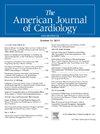Right Ventricular-Pulmonary Arterial Uncoupling as a Predictor of Invasive Hemodynamics and Normotensive Shock in Acute Pulmonary Embolism
IF 2.1
3区 医学
Q2 CARDIAC & CARDIOVASCULAR SYSTEMS
引用次数: 0
Abstract
Right ventricular–pulmonary arterial coupling describes the relation between right ventricular contractility and its afterload and is estimated as the ratio of the tricuspid annular plane systolic excursion (TAPSE) to pulmonary arterial systolic pressure (PASP) by way of echocardiography. Whether TAPSE/PASP is reflective of invasive hemodynamics or occult shock in acute pulmonary embolism (PE) is unknown. This was a single-center retrospective study over a 3-year period of consecutive patients with PE who underwent mechanical thrombectomy and simultaneous pulmonary artery catheterization with echocardiograms performed within 24 hours before the procedure.
A total of 70 patients (81% intermediate risk) had complete invasive hemodynamic profiles and echocardiograms, with TAPSE/PASP calculated. The optimal cutoff for TAPSE/PASP as a predictor of a reduced cardiac index (CI) (CI ≤2.2 L/min/m2) was 0.34 mm/mm Hg, with an area under the curve of 0.97 and sensitivity, specificity, positive predictive value, and negative predictive value of 97.3%, 90.9%, 92.3%, and 96.8%, respectively. Every 0.1 mm/mm Hg decrease in TAPSE/PASP was associated with a 0.24-L/min/m2 decrease in the CI. This relation was similar when restricted to intermediate-risk PE. The TAPSE/PASP ratio was predictive of normotensive shock with an odds ratio of 2.63 (95% confidence interval 1.42 to 4.76, p = 0.002) per unit decrease in the ratio.
In conclusion, in patients with acute PE who underwent mechanical thrombectomy, TAPSE/PASP was a strong predictor of a reduced CI and normotensive shock. This means that noninvasive point-of-care assessment of hemodynamics may have added value in PE risk stratification.
右心室-肺动脉不偶联作为急性肺栓塞时侵入性血流动力学和正常血压休克的预测因子
右心室-肺动脉(RV-PA)耦合描述了右心室收缩力与其后负荷之间的关系,并通过超声心动图以三尖瓣环平面收缩期偏移(TAPSE)与肺动脉收缩压(PASP)之比来估算。TAPSE/PASP能否反映急性肺栓塞(PE)的有创血流动力学或隐性休克尚不清楚。这是一项为期 3 年的单中心回顾性研究,研究对象是接受机械血栓切除术和同步肺动脉导管检查的连续 PE 患者,术前 24 小时内进行了超声心动图检查。70 名患者(81% 为中危患者)接受了完整的有创血液动力学检查和超声心动图检查,并计算出了 TAPSE/PASP。TAPSE/PASP 预测心脏指数降低(CI≤ 2.2 L/min/m2)的最佳临界值为 0.34 mm/mmHg,AUC 为 0.97,敏感性、特异性、阳性预测值和阴性预测值分别为 97.3%、90.9%、92.3% 和 96.8%。TAPSE/PASP 每下降 0.1 mm/mmHg,CI 值就会下降 0.24 L/min/m2。如果仅限于中危 PE,这种关系也类似。TAPSE/PASP 比值每降低一个单位,预测正常血压休克的 OR 值为 2.63(95% CI:1.42, 4.76,p=0.002)。总之,接受机械血栓切除术的急性 PE 患者,TAPSE/PASP 是预测 CI 降低和正常血压休克的有力指标。这种非侵入性的床旁血流动力学评估方法可能会为 PE 风险分层带来更多价值。
本文章由计算机程序翻译,如有差异,请以英文原文为准。
求助全文
约1分钟内获得全文
求助全文
来源期刊

American Journal of Cardiology
医学-心血管系统
CiteScore
4.00
自引率
3.60%
发文量
698
审稿时长
33 days
期刊介绍:
Published 24 times a year, The American Journal of Cardiology® is an independent journal designed for cardiovascular disease specialists and internists with a subspecialty in cardiology throughout the world. AJC is an independent, scientific, peer-reviewed journal of original articles that focus on the practical, clinical approach to the diagnosis and treatment of cardiovascular disease. AJC has one of the fastest acceptance to publication times in Cardiology. Features report on systemic hypertension, methodology, drugs, pacing, arrhythmia, preventive cardiology, congestive heart failure, valvular heart disease, congenital heart disease, and cardiomyopathy. Also included are editorials, readers'' comments, and symposia.
 求助内容:
求助内容: 应助结果提醒方式:
应助结果提醒方式:


